Words of Wisdom - Shastra
& Shastrakaras speak
For Books and shastra downloads see Main Index, under
Books:
Om Namo Bhagavate Vasudevaya
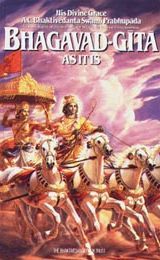

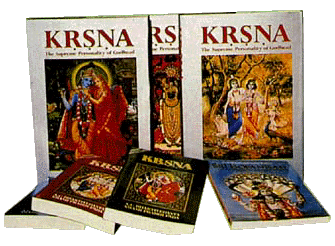
The Complete Works of Srila Prabhupada
All the books, the letters and conversations at your
fingertips
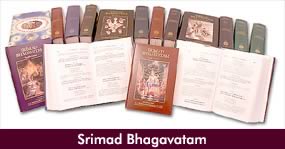

All Srila Prabhupada's books and more on one disk
http://www.vedabase.com




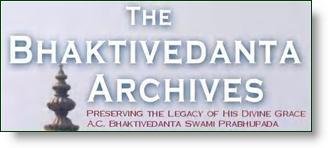
Srila Prabhupada's Audio lectures to listen to on-line:
http://www.hare-krishna.org/srila-prabhupada-lectures.htm
Listen to Srila A.C. Bhaktivedanta Swami Prabhupada on-line
- all 900 of his lectures are available HERE:
http://www.prabhupadavani.org/
Srimad Bhagavatam - the entire lecture series listen and
read along on-line - Narrated by Amala Bhakta dasa:
http://www.prabhupadavani.org/SB_index.html
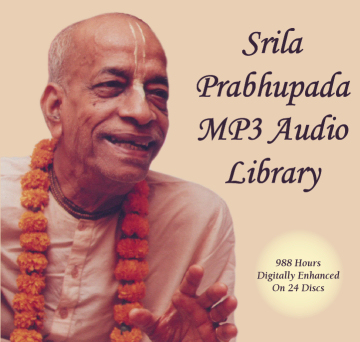
The new enhanced Prabhupada MP3 series
http://www.prabhupada.com/store/store.php?page=product.php&id=MP3AUDIOLIB








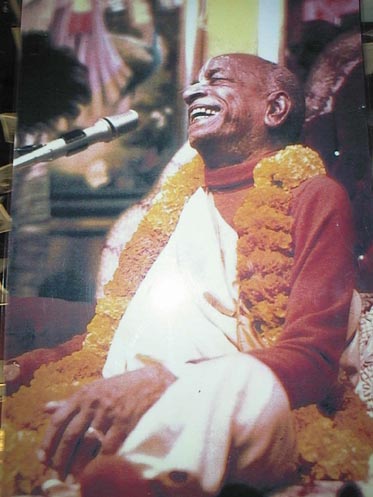
Visit "Prabhupada Connect" for all manner of Prabhupad
Nectar:
http://www.prabhupadaconnect.com/Index.html
Srila Prabhupada's Final Lesson Video - Downloadable and
viewing on-line
http://users.iskconludhiana.com/images/thumbnails.php?album=21


All Srila Prabhupada's original books
available for sale here.

Download all the Hare Krsna teachings which includes
all Vaisnava and
Vedic concepts by visiting one of the sites listed at
the following address.
http://www.geocities.com/suci123/bookdownloadsites1.html
The Bhaktivedanta Book Trust
Srila Prabhupad Memorial Library
http://www.krishna.com/main.php?id=33


33 Books Online Including Srimad Bhagavatam!
http://www.geocities.com/freeprabhupadabooks
The compressed "self extracting" file mentioned is now currently
available for download
http://www.krsnaconsciousness.org/Gauranga/Folio/BhaktivedantaVedabase_DOS.exe

Download or Listen to Prabhupad Bhajans HERE:
http://www.prabhupadavani.org/web/text/Bhajans.html


On-line 1972 McMillan edition - Bhagavad Gita As It Is:
http://www.asitis.com/

Bhagavad Gita AS IT IS on-line through the Tirupathi
Balaji site:
http://www.bhagavad-gita.us/

Bhagavad Gita Study guide on-line book:
http://chantandbehappy.com/gita/studyguide/StudyGuide-main.htm
Bhagavad Gita Study guides by numerous Iskcon devotees
- FREE downloads:
http://www.veda.harekrsna.cz/library/#3

All the Scriptures you'd ever need 4 FREE
http://www.hknet.org.nz/index-books.htm
http://www.hknet.org.nz/DDB.htm
http://www.hknet.org.nz/DDB2.html
last updated 4th August 2003


Srimad Bhagavad Gita AS
IT IS
Bhagavad Gita: Chapter
6 - Dhyana-yoga
TEXT 7
jitatmanah prasantasya
paramatma samahitah
sitosna-sukha-duhkhesu
tatha manapamanayoh
WORD FOR WORD
jita-atmanah--of one who has conquered his mind; prasantasya--who
has attained tranquillity by such control over the mind; parama-atma--the
Supersoul; samahitah--approached completely; sita--in cold; usna--heat;
sukha--happiness; duhkhesu--and distress; tatha--also; mana--in honor;
apamanayoh--and dishonor.
TRANSLATION
For one who has conquered the mind, the Supersoul is already
reached, for he has attained tranquillity. To such a man happiness and
distress, heat and cold, honor and dishonor are all the same.
PURPORT by His Divine Grace Srila A.C. Bhaktivedanta Swami Prabhupad:
Actually, every living entity is intended to abide by the
dictation of the Supreme Personality of Godhead, who is seated in everyone's
heart as Paramatma. When the mind is misled by the external, illusory
energy, one becomes entangled in material activities.
Therefore, as soon as one's mind is controlled through
one of the yoga systems, one should be considered to have already reached
the destination. One has to abide by superior dictation. When one's mind
is fixed on the superior nature, he has no alternative but to follow the
dictation of the Supreme. The mind must admit some superior dictation and
follow it. The effect of controlling the mind is that one automatically
follows the dictation of the Paramatma, or Supersoul. Because this transcendental
position is at once achieved by one who is in Krsna consciousness, the
devotee of the Lord is unaffected by the dualities of material existence,
namely distress and happiness, cold and heat, etc. This state is practical
samadhi, or absorption in the Supreme.
His Divine Grace A.C. Bhaktivedanta Swami Prabhupada
Copyright 1983 The Bhaktivedanta Book Trust International. Used with
permission.

Bhagavad Gita As It Is - http://www.asitis.com/
Bhaktivedanta Vedabase - Bhagavad Gita on-line http://bhagavadgitaasitis.com/
Bhaktivedanta VedaBase: Bhagavad-gita As It Is http://vedabase.net/bg/en
Bhagavad Gita Multi Media Web-version http://chantandbehappy.com/gita/
Listen to Bhagavad Gita on line - http://www.Gitamrta.org
View our Bhagavad Gita Overview:
http://www.hknet.org.nz/BG.html
Archive: http://www.cs.rice.edu/~vivek/btg/archive/
Home Page: http://www.cs.rice.edu/~vivek/btg/
Join Bhagavad Gita eGroups HERE
mailto:bhagavad_gita-owner@egroups.com


Prabhupada Uvacha:
(here's some nectar, sometimes it comes in the form of Srutakirti prabhu's
diary, other times from Govinda dasi's diary, Hari Sauri prabhu's Transcendental
Diary, or sometimes from a letter, or other related source, but still nectar...)
Krsna takes such luglus with Him when He goes
out to play
One day I brought a painting done by our artist
Muralidhara for Prabhupada's approval. On Prabhupada's request, Muralidhara
had reproduced on canvas the Srimad-Bhagavatam jacket cover showing the
spiritual sky. As I held the painting up, Prabhupada began to explain the
plan of the creation. First he pointed to where Krsna was and described
how the entire creation was an expansion of Krsna's energy. The Vaikuntha
planets, broad and effulgent, were unlimited in number. Then Prabhupada
pointed to the corner of the painting where the material world was situated.
Maha-Visnu is lying down there, and millions of universes emanate from
His skin holes. Prabhupada said, "Each universe is filled up with unlimited
numbers of living entities who inhabit all of the planets and stars. One
of these planets is our earth, and on this planet are many continents.
On one continent there is America, and in America there are so many big
cities. Here is Los Angeles, and in Los Angeles there is a street, La Cienega
Boulevard. On this boulevard, among all of the buildings, is a temple of
Lord Krsna. And in this temple there is one Tamal Krishna. He is there,
and is thinking that he is very important." Then Prabhupada looked at me
and smiled. He was showing me how unimportant I really was. The lesson
was clear: no one had the right to become puffed up, no matter how important
his position might seem to be. In comparison with Krsna, the cause of all
causes, each jiva is tiny and insignificant. But despite this vast difference
between the Lord and the living entity, Krsna allows His pure devotees
to associate with Him equally. Prabhupada was kindly revealing the unlimited
extent of Krsna's glories. His silent smile communicated the deep love
he felt for Krsna and his desire to share it with his disciples. There
were other, similar moments when Prabhupada would allow us to enter into
the intimacy of his spiritual emotions. Once, after returning in the evening
from the temple, we stepped into his room, which was lit only by the light
over the altar. Radha and Krsna stood bathed in the soft light;, which
resembled the autumn moon in Vrndavana. Krsna, His body covered with jewels
and fine cloth, played upon His flute, and Radharani, His eternal consort,
held a garland of delicate jasmine flowers. When Prabhupada beheld Their
effulgent, golden forms, he stood still and exclaimed, "Just see! Radha
and Krsna are dancing tonight!" And on another occasion, Prabhupada offered
me a luglu which he had personally prepared and asked that I please taste
it and tell him how I liked it. Truthfully, I had never experienced any
taste with which it could he compared. "It is out of this world," is all
that I could say. And Prabhupada replied, "Yes, it is not of this world.
Krsna takes such luglus with Him when He goes out to play in the fields.
Wherever He goes, mother Yasoda fills His pocket with these luglus." Srila
Prabhupada's mood conveyed more than just something he had heard from a
book. He was speaking from realization from an intimate relationship which
he enjoyed with Krsna. Moments like these convinced me of Prabhupada's
extraordinary position. We were all so fortunate to be his disciples.
- From the "Servant of the Servant" by HH Tamala
Krsna Goswami
To receive little snippets of nectar like this on a daily basis subscribe
HERE: or If you want to introduce anyone else in reading Srila Prabhupada
Nectars, please send their eMail addresses to mailto:krpamaya_gauranga@hotmail.com
Please Chant:
 Hare
Krishna Hare Krishna Krishna Krishna Hare Hare
Hare
Krishna Hare Krishna Krishna Krishna Hare Hare
 Hare
Rama Hare Rama Rama Rama Hare Hare
Hare
Rama Hare Rama Rama Rama Hare Hare
...................and be Happy

Listen to Srila Prabhupad on-line
....a different lecture, morning walk, conversation or
class daily.
"Be A Great Master - Give God's
Message"
>>> Ref. VedaBase => Bhagavad-gita 4.1-2 -- Columbus, May 9, 1969
Listen to the entire lecture on-line:
http://prabhupadaradio.com/M3U/Gita/m3u/GT124.m3u
Pradyumna: Bhagavad-gita, chapter number four, "Transcendental
Knowledge."
One: "The Blessed Lord said, I instructed this imperishable
science of yoga to the sun-god Vivasvan, and Vivasvan instructed it to
Manu, the father of mankind. And Manu in turn instructed it to Iksvaku."
Purport: "Herein we find the history of the Bhagavad-gita traced from a
remote time when it was delivered to the kings of all planets. The royal
order is especially dedicated to the protection of the inhabitants, and
as such, its members should also understand the science of the Bhagavad-gita
in order to rule the citizens and protect them from the onslaught of material
bondage to lust. Human life is meant for cultivation of spiritual knowledge,
an eternal relationship with the Supreme Personality of Godhead, and the
executive heads of all states and all planets are obliged to impart this
lesson to the citizens by education, culture, and devotion."
Prabhupada: Hm. Stop. So in this verse the exact Sanskrit
word is
imam vivasvate yogam
proktavan aham avyayam
vivasvan manave praha
manur iksvakave 'bravit
[Bg. 4.1]
evam parampara-praptam
imam rajarsayo viduh
sa kaleneha (mahata)
yogo nastah parantapa
[Bg. 4.2]
So this Bhagavad-gita, science of Bhagavad-gita, is not
a new presentation. Just from this verse we can understand that it was
instructed to the sun-god. Sun-god, apart from what is the duration of
age of sun-god, but from the Manu, because the next statement is vivasvan
manave praha... Vivasvan. The sun-god's name is Vivasvan. Just like your,
the chief executive head is called the president, similarly, there is a
chief executive head also in the sun planet, president. And the present
president's name is... Just like your present president's name is Mr. Nixon,
similarly, the present predominating deity in the sun planet is known as
Vivasvan. So everything is in detail.
This is called Vedic literature. Vedic literature is not
concerned only with this planet. Vedic literature deals with all the universal
planets. Just see here is the statement. Krsna says that "In the beginning
I explained this science of Bhagavad-gita to the present predominating
deity of sun planet, whose name is Vivasvan." Do you think that Krsna is
playing joke or speaking something lie, that he said to Vivasvan, the present
presiding deity? No, that is not possible. Actually He has spoken. And
Krsna... One... Others may think of Krsna... Avajananti mam mudhah [Bg.
9.11]. Rascals and fools may think of Krsna as ordinary man, but in India
the great acaryas, just like Sankaracarya, Ramanujacarya, Madhvacarya,
Lord Sri Caitanya Mahaprabhu -- practically these acaryas are guiding the
whole destiny of the Hindu world -- they have all accepted Krsna, the Supreme
Personality of Godhead. So whatever Krsna is speaking, that is right.
Now, you can understand that if Krsna spoke to the sun-god,
and the sun-god spoke to his son Manu, then how old is this science of
Bhagavad-gita. Apart from sun-god's duration of age, if we simply take
the present age, Vaivasvata Manu, Vaivasvata Manu, the age of Vaivasvata
Manu is seventy-one multiplied by forty-three hundred thousands of years.
Forty-three hundred thousands of years multiplied by seventy-one. It is
a very long duration of life. Now, at the present moment the Vivasvan,
the Vaivasvata Manu's age is half-finished. That means the number, the
numerical strength, forty-three hundred thousands of years into seventy-one,
divide by two. So long years Bhagavad-gita was spoken.
continued.......................
Listen to the entire lecture on-line:
http://prabhupadaradio.com/M3U/Gita/m3u/GT124.m3u
or receive in mailbox and Subscribe HERE:
mailto:lectures-subscribe@prabhupadavani.org
Sravanam kirtanam at:
http://www.PrabhupadaVani.org
© 2001 The Bhaktivedanta Book Trust International. Used with permission.

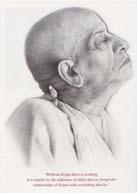
SRILA PRABHUPADA'S QUOTE OF THE DAY
The more you serve, the more
you relish taste. Without relishing taste, nobody can render devotional
service. It is practical.
The Nectar of Devotion,
Vrndavana 1972
Sign-up to receive these quote HERE:
mailto:haribol@pacific.net.sg

Bhaktivedanta Vedabase Network ...
http://vedabase.net/


The Scientific - Mathematical
Proof for God's existence:
http://geocities.com/sector114

http://robot-hosting.com/php/login_nicholas.html
user name = guest
password = guest
(Collection of philosophical and mathematical proofs
for existence of God can be found in this site.)

Scientifically Philosophical Books for the layman
 ...
... ...
...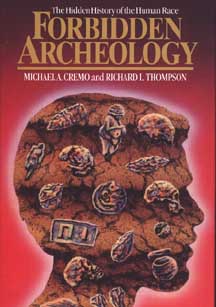 ...
...
Click on any of these books to read more about them and where to get
a copy
or contact your local temple for purchases
sample of Life
comes from Life HERE.pdf

Lotus Imprints - Preserving Prabhupada's Legacy - The
Publishing House of Hari Sauri dasa
http://www.lotusimprints.com/

Quotes from Shastra - scriptures
View using Balaram font

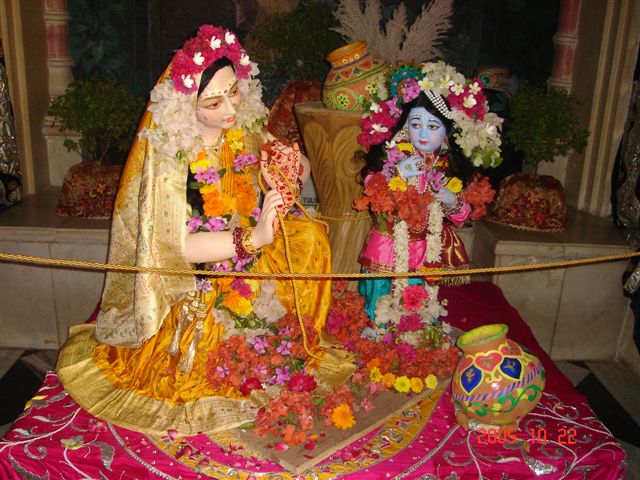

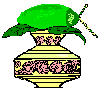 The
Month of Karttika
The
Month of Karttika
8th October to 5th November 2006
All about the Month of Karttik HERE
and how to observe
Kartik Vrata & Festivals
of Kartika
Kartika mahatmya from 16th chapter Hari
Bhakti Vilasa - see below
All manner of
inspiring nectar regarding Kartika vrat - what to do and the benefits thereof........
View this .pdf file "The Glories
of Karttika"
Information about Karttika (Damodara) Vrata:
Performing vrata in the month of Kartika (Damodara) is glorified profusely
in the puranas. Since this month is very dear to Krsna by performing austerities,
or restraining ones sense gratification and performing activities to please
the senses of the Lord, one becomes very dear to the Krsna. As Satya yuga
is the best of yugas, as the vedas are the best of scriptures, as ganga
is the best of rivers, so kartika is the best of months, the most dear
to Krsna. The vrata may begin on the ekadasi of the waxing moon of asvina,
on the purnima, or (samkranti) when the sun enters the house of Libra.
Five activities are glorified: staying awake, early morning bath, worship
of Tulasi, offering lamps and performing austerities.
One should practice brahmacarya, give charity, and perform homa and
japa.
One is advised to give up eating beans, kalami saka, patola, eggplant,
meat, fish, liquor, oil massage, illicit sex, grains cooked by others.
One should eat once a day havisana.
One should increase ones devotional service by performing more deity
worship, hearing and speaking about the Lord, by extra japa of the Lord's
name, worshipping tulasi, staying awake at night chanting, visiting holy
tirthas and offering lamps to the Lord.
One should worship Radha Damodara and recite the Damodarastaka daily.
More on Chaturmasya vratas HERE:
Sri Dik Darshini Tika and Hari Bhakti
Vilas on the Month of Karttika, Urja Vrata, Damodar Utsav seva, Akash Dipa:
KARTIKE'SMIN VISESENA NITYAM KURVITA VAISNAVAH
DAMODARA ARCANAM PRATAH SNANA DANA VRATA ADIKAM
(HARI BHAKTI VILASA 16/3 from SKANDA PURANA)
Specifically in the month of Damodara, one should daily worship
Lord Damodara and take bath early in the morning, give charity and follow
a fasting vow. This is the duty of Vaisnavas.
NIYAMENA VINA VIPRAH KARTIKAM YAH KSIPEN NARAH
KRSNA PARAN-MUKHAS TASYA YASMAD URJO'SYA VALLABHAH
(HARI BHAKTI VILASA 16/24 from PADMA PURANA conversation between Narada
Muni and Saunaka Rsi)
Oh brahmanas, any person who tries to observe a Karttika month
without following rules and regulations properly, Lord Sri Krsna remains
against them because this month (Karttika) is very pleasing to Him.
YAIR NA DATTAM HUTAM JAPTAM NA SNANAM NA HARER VRATAM
NA KRTAM KARTIKE PUTRA DVIJAS TE VAI NARADHAMAH
(HARI BHAKTI VILASA 16/25 from SKANDA PURANA)
Oh son Narada, those brahmanas who do not give charity in the
month of Karttika, perform sacrifice, chant japa and fast for Lord Hari
are the lowest of mankind.
KARTIKA KHALU VAI MASAM SARVA MASESU CA UTTAMAM
PUNYANAM PARAMAM PUNYAM PAVANANAM CA PAVANAM
(HARI BHAKTI VILASA 16/36 from SKANDA PURANA)
The month of Karttika is the topmost of all other months. It is
the most meritorious and purified of all other pure months.
NA KARTIKA SAMO MASO NA KRTENA SAMAM YUGAM
NA VEDA SADRSAM SASTRAM NA TIRTHA GANGAYA SAMAM
KARTIKAH PRAVARO MASO VAISNAVANAM PRIYAH SADA
KARTIKAM SKALAM YASTU BHAKTYA SEVATE VAISNAVAH
(HARI BHAKTI VILASA 16/39,40 from SKANDA PURANA)
There is no other month equal to Karttika and there is no other
yuga equal to Krta-yuga. There is no other scripture equal to Vedas. There
is no other place of pilgrimage equal to Ganges, therefore, the month of
Karttika is very dear to the Vaisnavas (people dedicated to Visnu).
DVADASU API MASESU KARTIKAH KRSNA VALLABHAH
TASMIN SAMPUJITO VISNUR ALPAKAIR APY UPAYANAIH
DADATI VAISNAVAM LOKAM ITI EVAM NISCITAM MAYA
(HARI BHAKTI VILASA 16/41 from PADMA PURANA)
Among all twelve months, the month of Karttika is dear to Lord
Sri Krsna. If
somebody performs a little worship of Lord Sri Hari in this month,
He offers
that devotee His own abode. This statement is true.
PRAVRTTANAM CA BHAKSANAM KARTIKE NIYAME KRTE
AVASYAM KRSNA RUPATVAM PRAPYATE MUKTIDAM SUBHAM
(HARI BHAKTI VILASA 16/49 from SKANDA PURANA)
Whatever one usually eats, if he gives up some of the ingredients
of it in the month of Karttika, then he achieves the same aupicious form
as Lord Sri Krsna undoubtedly.
Srila Sanatana Gosvami remarks in the Digdarsini-tika, "Those
who are engaged in eating daily and following the rules of Karttika, they
should try to minimize and give up certain ingredients in eating. Obtaining
the same form as Krsna means that it liberates one from the miseries of
this material world and gives all auspiciousness and happiness."
SARVA DHARMAN PARITYAJYA KARTIKE KESAVA AGRATAH
SASTRA AVATARANAM PUNYAM SROTAVYAN CA MAHAMUNE
(HARI BHAKTI VILASA 16/76 from SKANDA PURANA Lord Brahma speaks to Narada
Muni)
Oh great sage, after giving up all varieties of religious functions,
one
should follow Karttika fast and listen to the narrations of Lord Sri
Hari
before His Deity form.
PALASA PATRA BHOJI CA KARTIKE PURUSO NARAH
NISPAPAH SYAT TU NAIVEDYAM HARER BHUKTVA VIMUCYATE
MADHYASTHAM ISVARAM PATRAM VARJAYED BRAHMANE TARAH
(HARI BHAKTI VILASA 16/87 from PADMA PURANA)
Any person in the month of Karttika, who eats on the leaf plate
of Palasa the remnants of the Lord, becomes free from all sins and achieves
liberation. Besides brahmanas (twice born persons), others are not advised
to eat from this leaf because this leaf is said to be the leaf of the Supreme
Lord.
SNANAM JAGARANAM DIPAM TULASI VANA PALANAM
KARTIKE YE PRAKURVANTI TE NARA VISNU MURTAYAH
(HARI BHAKTI VILASA 16/90 from PADMA PURANA Lord Krsna speaks to Satyabhama)
Any person who performs bathing in the month of Karttika, remaining
awake, offering lamps, giving charity or planting and transplanting Tulasi,
he achieves the same form as Lord Sri Visnu.
KALPA KOTI SAHASRANI PATKANI BAHUNY API
NIMESA ARDHENA DIPASYA VILAYAM YANTI KARTIKE
(HARI BHAKTI VILASA 16/99 from SKANDA PURANA)
If even for a short time somebody burns a lamp in the temple of
Lord Sri Hari, then whatever sins he has acquired for millions of kalpas
(one kalpa equals 1000 yugas) are all destroyed.
YATHA CA MATHANAD VAHNIH SARVA KASTHESU DRSYATE
TATHA CA DRSYATE DHARMO DIPADANE NA SAMSAYAH
(HARI BHAKTI VILASA 16/120 from PADMA PURANA)
Just as by rubbing of two sticks of wood one can see fire, so
by offering a burning ghee wick to the Lord in the month of Karttika, one
can see his merits without a doubt.
In his Digdarsini-tika Srila Sanatana Gosvami explains, "Even
though fire is present in all pieces of wood, still without rubbing fire
does not manifest. Similarly, in all kinds of functions, although merit
is available, by offering a lamp in this month, certainly one can see the
merit. Not otherwise. Of this there is no doubt. Therefore, without offering
lamps, all merits are unprofitable. This is the essence here."
VAISNAVO NA SA MANTAVYAH SAMPRAPTE KARTIKE MUNE
YO NA YACCHATI MUDHATMA DIPAM KESAVA SADMANI
(HARI BHAKTI VILASA 16/122 from PADMA PURANA)
Oh sage, a person who does not offer a ghee lamp in Lord Kesava's
temple in Karttika, that foolish person is not addressed as a Vaisnava.
EKADASYAM PARER DATTAM DIPAM PRAJVALYA MUSIKA
MANUSYAM DURLABHAM PRAPYA PARAM GATIM AVAPA SA
(HARI BHAKTI VILASA 16/129 from SKANDA PURANA)
One rat (female mouse) had once burnt a ghee lamp which was offered
by someone else on Ekadasi day. By doing so, she achieved a rarely achievable
human form and at last attained the topmost destination.
Srila Sanatana Gosvami writes in his Digdarsini-tika, "In this
verse it is found that it is possible to attain the results of directly
offering a lamp on Ekadasi. This history of the mouse is very famous in
the Padma Purana, Kartika Mahatmya. (In a temple of Lord Visnu, there was
a mouse living who was eating the ghee from the extinguished ghee lamps
which had been offered by others to Him. One day when she felt hungry to
eat ghee, she tried to eat the ghee from a lamp which was not yet extinguished.
While eating ghee from the lamp, the cotton wick got stuck in her teeth.
Since the ghee wick had a flame, the mouse started jumping in front of
the Lord's Deity form and thus died due to fire. But Lord Sri Visnu accepted
the jumping of that mouse with a lit ghee wick in her mouth as His aratik.
In the end He gave her liberation, the topmost destination.)
MATHURAYAM NARAIR URJE SNATVA DAMODARO'RCITAH
KRSNA RUPA HI TE JNEYA NA ATRA KARYA VICARANA
(HARI BHAKTI VILASA 16/155 from PADMA PURANA)
Any person who worships Lord Damodara in the month of Karttika
in the Mathura area, certainly achieves the same form as Lord Sri Krsna
Himself.
Srila Sanatana Gosvami comments on this in his Digdarsini-tika,
"Human beings achieving the same form as Krsna means that they see Lord
Sri Krsna. In other words, they become as worshipable as Lord Sri Krsna.
This this the understanding here."
KARTIKE MATHURAYAM VAI PUJANAD DARSANAD DHRUVAH
SIGHRAM SAMPRAPTAVAN BALO DURLABHAM YOGA TATPARAIH
(HARI BHAKTI VILASA 16/161 from PADMA PURANA)
Although a child, Dhruva Maharaja during the month of Karttika
in the area of Mathura worshiped Lord Sri Damodara and immediately became
fixed in his devotion, became worshipable by Saunaka and the other sages
and saw the Supreme Personality of Godhead face to face.
SULABHA MATHURA BHUMAU PRATY ABDAM KARTIKAS TATHA
TATHAPI SAMSARANTIHA NARA MUDHA BHAVA AMBUDHAU
YANI SARVANI TIRTHANI NADA NADYAH SARANSI CA
KARTIKE NIVASANTY ATRA MATHURE SARVA MANDALE
(HARI BHAKTI VILASA 16/162,164 from PADMA PURANA)
Although Mathura (Vraja area) is easily available on the earth
and Karttika is easily attainable in the year, but oh, what a great misfortune
in the side of human beings who are still suffering in the ocean of material
existence. In the month of Karttika, all of the places of pilgrimage, oceans,
rivers and lakes come to Mathura area [but they do not take advantage of
it.]
ASVINASYA TU MASASYA YA SUKLA EKADASI BHAVET
KARTIKASYA VRATA ANIHA TASYAM KURYAD ATANDRITAH
(HARI BHAKTI VILASA 16/168 from PADMA PURANA conversation between Lord
Krsna
and Satyabhama)
One should take a fasting vow for the month of Karttika without
any laziness on the Ekadasi which falls in the light part of the month
of Asvina (September-October).
NA GRAHE KARTIKE KURYAD VISESENA TU KARTIKAM
TIRTHE TU KARTIKIM KURYAT SARVA YATNENA BHAVINI
(HARI BHAKTI VILASA 16/186 from SKANDA PURANA)
Oh beautiful lady, specifically, one should not take a vow of
fasting in the Karttika month in the home or house. Always the endeavor
should be made to go to a place of pilgrimage to make this vow and observe
it there.
TATAH PRIYATAMA VISNO RADHIKA GOPIKASU CA
KARTIKE PUJANIYA CA SRI DAMODARA SANNIDHAU
(HARI BHAKTI VILASA 16/195 from PADMA PURANA)
Among all other gopis, Srimati Radharani is the most dear to Lord
Krsna. Therefore in the month of Karttika, one should worship Lord Damodara
with Srimati Radharani near Him.
DAMODARA ASTAKAM NAMA STOTRAM DAMODARA ARCANAM
NITYAM DAMODARA AKARSI PATHET SATYA VRATA UDITAM
(HARI BHAKTI VILASA 16/198)
In the month of Karttika, one should
daily worship Lord Damodara and sing the Damodarastaka (the eight prayers
of Lord Damodara) which pleases Lord Damodara, written by the sage named
Satyavrata.
GOVARDHANA GIRAU RAMYE RADHAKUNDAM PRIYAM HAREH
KARTIKE BAHULA ASTAMYAM TATRA SNATVA HAREH PRIYAH
NARO BHAKTO BHAVED VIPRAS TADDHI TASYA PRATOSANAM
(HARI BHAKTI VILASA 16/207 from PADMA PURANA)
Oh brahmanas, in the beautiful Govardhana
area there is a Radhakunda (a lake of Radharani)
which is very dear to Lord Sri Hari. One who takes
bath in it on the eighth day of the dark moon night of Karttika, becomes
very dear to Lord Sri Hari.
Srila Sanatana Gosvami remarks in his Digdarsini-tika that, "Although
by taking bath in Radhakunda one becomes very
dear to Lord Sri Hari, still, if he takes bath anywhere in the name of
pleasing Lord Hari, he pleases Him as well.
SRI KRSNA DASA VARYO'YAM SRI GOVARDHANA BHUDHARAH
SUKLA PRATIPADI PRATAH KARTIKE'RCYU 'TRA VAISNAVAIH
(HARI BHAKTI VILASA 16/232 from SKANDA PURANA)
On the first day of the light part of the month of Karttika, a
Vaisnava should certainly worship the topmost servant of Lord Sri Krsna,
Sri Govardhana Hill, early in the morning as it is found in the Srimad
Bhagavatam, 10th Canto, 21 chapter, verse 18.
MATHURAYAM TATHA SAKSAT KRATVA CAIVA PRADAKSINAM
VAISNAVAM DHAMA SAMPRAPYA MODATE HARI SANNIDHAU
(HARI BHAKTI VILASA 16/249 from PADMA PURANA)
One who stays in the Mathura area, worships
Govardhana, and goes around it, he goes to the abode of Lord Sri Hari
and stays there happily.
URJE SUKLA DVITIYAYAM MADHYAHE YAMA ARCAYET
SNANAM KRTVA BHANUJAYAM YAMA-LOKAM NA PASYATI
(HARI BHAKTI VILASA 16/267 from SKANDA PURANA and PADMA PURANA)
On the midpart of the second day of the light part of the month
of Karttika one should worship Yamaraja and take bath in the Yamuna. If
he does so, he will not have to go to the abode of Yamaraja.
PRABODHINIM UPOSYA EVA NA GARBHE VISATE NARAH
SARVA DHARMAN PARITYAJYA TASMAT KURVITA NARADA
(HARI BHAKTI VILASA 16/289 from SKANDA PURANA spoken by Lord Brahma)
Oh Narada Muni, one who fasts on Prabodhini
(when the Lord gets up) Ekadasi, does not
enter again into the womb of another mother. Therefore, a person should
give up all varieties of occupation and fast on this particular Ekadasi
day.
DUGDHABDHIH BHOGI SAYANE BHAGAVAN ANANTO
YASMIN DINE SVAPITI CA ATHA VIBHUDHYATE CA
TASMINN ANANYA MANASAM UPAVASA BHAJAM
KAMAM DADATY ABHIMATAM GARUDANKA SAYI
(HARI BHAKTI VILASA 16/293 from PADMA PURANA)
One who fasts with one pointed intelligence on the day when the
Supreme Lord Sri Hari, Who sleeps on a bed of the enemy of Garuda (snake)
goes to take rest in the Milk ocean on the bed of Ananta Sesa and also
the day He gets up, gets all of his desires fulfilled.
BHAKTIPRADA HAREH SATU NAMNA KSATA PRAVODHINI
YASA VISNOH PARA MURTIR AVYAKTA ANEKA RUPINI
SA KSIPTA MANUSE LOKE DVADADI MUNI PUNGAVA
(HARI BHAKTI VILASA 16/301 from VARAHA PURANA conversation between Yamaraja
and Narada Muni)
This Prabodhini Ekadasi is famous
for rewarding devotion to Lord Sri Hari. Oh best of the sages (Narada Muni),
the personality of Ekadasi is present on this earthly planet in an unmanifested
form of Lord Hari.
Srila Sanatana Gosvami remarks in his Digdarsini-tika that one
who exactly observes the Ekadasi fast by observing this, he directly worships
Lord Sri Hari. This is the meaning of this verse. Therefore, Ekadasi is
said to be equal to Lord Sri Hari Himself.
CATUR DHA GRAHYA VAI CIRNAM CATUR MASYA VRATAM NARAH
KARTIKE SUKLAPAKSE TU DVADASYAM TAT SAMACARET
(HARI BHAKTI VILASA 16/412 from MAHABHARATA)
A person who observed Caturmasya fast stated in four different
ways should end his fast on the Dvadasi day on the light fortnight of the
month of Karttika.
EVAM YA ACARET PARTHA SOBHANAM DHARMAM APNUYAT
AVASANE TU RAJENDRA VASUDEVA PURAM VRAJET
(HARI BHAKTI VILASA 16/433 from BHAVISYA UTTARA PURANA)
Oh son of Prtha, Oh best of the kings, one who follows his vows
properly as it is stated here achieves the highest merit and at last goes
to the abode of Lord Sri Hari, the son of Vasudeva.
MALATI MALAYA VISNUH PUJITO YENA KARTIKE
PAPAKSARA KRTAM MALAM HATHAT SAURIH PRAMARJJATI
(HARI BHAKTI VILASA 7/92 from SKANDA PURANA conversation between Lord
Brahma and Narada Muni)
In the month of Karttika (October-November), any person, if he
worships Lord Visnu with Malati (white Jasmine) flowers, whatever sinful
activities are registered for him by Yamaraja, death personified, are removed.
KAMALAIH KAMALAKANTAH PUJITAH KARTIKE TU YAIH
KAMALA ANUGA TESAM JANMANTARA SATESU API
(HARI BHAKTI VILASA 7/102 from PADMA PURANA, UTTARA KHANDA)
Any person who offers lotus flowers to Lord Narayana, the dearest
personality of Laksmidevi in the month of
Karttika, Laksmidevi resides with him for hundreds of births.

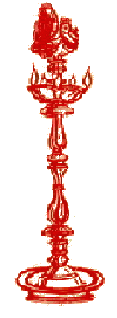 .....
..... .....
.....
Diwali - Dipavali - Dip dan - Akash dipa
Read about Diwali HERE
 The
Diwali Period.
The
Diwali Period.
The story goes that Hanuman was sent by Rama to Ayodhya
the day before Rama's arrival as prearranged with Bharat to let the residents
of Ayodhya know how Sita and Rama and all Their retinue were returning.
This was five days before Diwali, and after the Vijaya
dasami (victory of Rama ) celebration.
THE STORY BEHIND OF "DIWALI"
King Dashrath ruled the rich and prosperous city of Ayodhya.
He had three wives and Kaikayi was his favourite. She saved his life
in a war at a very crucial time. Dashrath granted her two favours
for saving his life.
Dashrath had four sons. Rama, the oldest, was everybody's
favourite. He was married to the beautiful and devoted Sita.
Just before Ram's coromation, Kaikayi reminded Dashrath of her two favors.
She told him to crown Bharat as king and to banish Ram to the jungle for
fourteen years. Her wishes were granted.
The old king Dashrath later died of a broken heart. After
a few years in the forest, Sita was lured by the demon king Ravana.
Rama, with the help of a monkey general, Hanuman, rescued Sita and defeated
Ravana. After fourteen years in exile Ram and Sita and returned to Ayodhya.
It is in Their honor that "Diwali" is celebrated.
"Diwali" signifies the victory of good over evil.
Today in India for Diwali all the shops are decorated
brightly. Many people make "rangoli" in their house or outside.
They are filled to capacity in this festive season. Everybody buys
new things and decorates their homes. People visit their friends
and relatives and give them sweets. On Diwali friends come over for the
whole day and relatives come and go. Everyone has a wonderful time
celebrating the return of Sita and Rama. Thus Diwali has become a day when
all the sad things of the past are forgotten and happy times are remembered.
The famous slOkam on DhIpAvaLi is:
thailE LAKSHMEE: JalE GANGAA dhIpAvaLi dhinE vasEth
alakshmI parihArArTam abhyangasnAnam aacharEth
Tatha Aabharanam vasthram dharEyEth sarvasampadhE
(meaning): On the early morning of DhIpAvaLi (before Sunrise of KrishNa
Paksha Chathurthi of Iypaasi Month ), MahA LakshmI resides in oil and GangA
Devi stays in the waters. For the sake of chasing away poverty / inauspiciousness,
One should take an oil bath and wash oneself with hot water and thereafter
wear new clothes. This is refered to in more detail below.
See the Kartika Mahatmya
from Hari Bhakti Vilas for the benefits of offering lamps in the month
of Kartik.
See also typical
Diwali foodstuffs offerings:
Send Diwali Cards from HERE:
http://ecards.rediff.com/ecards/category/ecat%7B24%7D_1.htm
http://www.123greetings.com/events/diwali/
More e-cards HERE
Please continue to scroll down to see the other days
in the Diwali fesitval season..........

 1st
day - Yam:
1st
day - Yam:
Generally people place one lamp out in the Southern direction.
Pray to Yamaraj to request the shakti to complete all
your tasks, fulfill your life and then safely return home.

 2nd
day - Narak Chaturdasi:
2nd
day - Narak Chaturdasi:
Lord Krishna killed Narakasura (the son of Hiranyaksha
and Bhumi Devi) he stole the 16000 princesses and did generally all manner
of bad things. Bhumi requested Krishna to come and kill the demon.
Devotees glorify Krishna as the personification of good,
who always triumphs and destroys evil - on this day!!!
Here's some details:
This is the day when Sathyabhama rode with the Lord to
the battle at PrakjyOthisha puram, the capital of Naraka-asuran and helped
her Lord to put an end to the adharmic - sinful acts of that Asuran. He
was a son of Bhumi Devi, but had strayed and committed many offenses against
the devotees oft he Lord. The compassionate Mother understood the role
of dushta Nigraham of Her Lord and prayed for Her son to be granted Moksham
and be remembered on the day of his destruction by the Sudarsanam discus
of the Lord.
Outside the slokams of Bhagavatham, the tradition is that
she prayed for the pristine waters of Ganga, which arose from the Lord's
feet from TrivikramAvatham time to enter into
the oil and waters at the home of pious devotees on this day, when they
take the oil bath in hot water during the early morning ( before sunrise
) of this Naraka Chathurthi day. She also prayed for all people to celebrate
her son's moksham as a pandigai wearing new clothes and eat special sweets
and nourishments. Lord KrishNA granted her wish and thus we celebrate this
day of DipAvaLi. We light fire crackers, light lamps and with "sound and
light" we celebrate this great deed of the Lord. We go around inquiring
our friends and relatives : " GangA SnAnam Aacchaa? " .
This is also the day, when the Lord brought the
PaarijAthA tree from Indra's Nandavanam to please SathyabhAma and planted
it in her garden at Dwaraka.

 3rd
Day - Bhaktasiroman Hanuman - this is where Hanuman
is worshipped.
3rd
Day - Bhaktasiroman Hanuman - this is where Hanuman
is worshipped.
Dhanteras:
Two days before the main festival of Deepawali is Dhanteras
in honour of Dhanwantari, the physician of the gods. He is considered a
minor incarnation of Vishnu and arose out of the Ocean of Milk, carrying
the pot of amrita, the drink of immortality. He is considered the father
of the Indian System of medicine called Ayurveda. Dhanteras is a part of
the Deepawali celebrations and not a festival in its own right. People
bathe early in the morning and observe a fast, which is broken only after
sunset, when the housewife lights an earthen lamp at the gate. New clothes
are worn on this day and a new utensil is bought which is kept at the place
of worship. (Shakti M Gupta. 1991. Festvals, Fairs and Fasts of India.139-142.)

 4th Day
- Sri Laxmi Puja:
4th Day
- Sri Laxmi Puja:
Lord Vishnu for the first time worhipped Laxmi on this
day. What happens is described in the next section on Diwali (Deepawali).
Laxmi
Puja.
Maha Lakshmi PoojA. This is also the day, when the new year accounts
are started by commercial houses and Maha Lakshmi pooja is performed with
great ceremony.

Some do KedAra Gauri poojA on this day (Shiva and Parvati pooja). However,
Gauri does not mean exclusively Parvathi. It also means a eight year
old Virgin girl. it also means speech, Turmeric and Tulasi. For Sri VaishNavas,
it means Bala Lakshmi. KedAram means a meadow rich with water or a collection
of water under the trunk of a tree. It is not just a mountain chain in
HimAlayAs. Hence, KedArA symbolizes richness or samrutthi or subheeksham.
Under this definition, KedAra Gauri Poojaa is then understood as PoojA
for the Goddess of Wealth, MahA Lakshmi.
Bhumi Devi's prayer to the Lord are moving and are housed in the
chapter 59 of the Dasama skandham (10th canto).
Here are some illustrative verses :
namasthE devadEvEsa sakha chakra gadhAdhara I
bhakthEccHOpAttha rUpAya ParamAthman namOsthu thE II
(meaning ) : Salutations to Thee , the God of Gods ! sporting the conch,
the disc and the mace ! Obesiance to Thee, the supreme Consciousness, who
assumest bodies to fulfill the yearnings of Thy devotees !
Nama: PankajanAbhAya Nama: PankajamAlinE I
Nama: PankajanEhtrAya NamasthE PankajaAngrayE II
( meaning ) : Salutations to the Lotus-navelled ! Salutations to the
Lotus-garlanded! Salutations to the Lotus eyed ! Salutations to the Lotus-footed
!
namO BhagavathE thubhyam VaasudEvAya VishNavE I
PurushAya AdhibheejAya PurNabhOdAya thE nama: I
(meaning ) : I salute VaasudEvA , the support of all ! I salute VishNu,
the inner pervader of everything ! I salute Him, who is the ultimate source
of everything ! I salute Him, who is All-Intelligence !
AjAya janayithrEasya BrahmaNE ananthasakthayE I
ParaavarAthman BhUthAthman Paramaathman namOsthu thE II
(Meaning ) : Salutations to Him , who manifests both as the cause and
the efect! Salutations to Him, who is ever existent ! Salutations to Him
, who is the supreme spirit ! Salutations to Him, Who is the Infinite power
! Salutations to Him , who is the greatest being ! Salutations to Him,
who is the father of the worlds ! Salutations to Him, who is birthless
!
OM NamO BhagavathE VaasudEvAya !
Today and tomorrow even more , all of us can benefit from reciting Sri
Sthuthi of Swami Desikan and Sri Sthavam of KurEsa and ChathusslOki
of AlavandhAr . We can also perform aaradhanam to Maha Lakshmi with Lakshmi
AshtOttharam or Lakshmi sahasra Naamam .
Those , who do not have the time can at least recite one slOkam
from Sri Sthuthi, which starts with KalyANAnAm avikala nidhi : and receive
Her blessings for the year to come !
Om Sriyai Nama:

 5th Day
- Amavasya, Dipavali - Dipanvita - Damodhar
lila happened.
5th Day
- Amavasya, Dipavali - Dipanvita - Damodhar
lila happened.
The 14 year period of exile of Lord Rama, Sita and Rama's
brother Laxman was completed, and Rama returns to Ayodhya on the Amavasya
night. When Lord Rama reached the outskirts of Ayodhya it was on the night
of the New Moon Day (Amavasya).The sky was very dark and Sri Rama enacted
the pastime that He could not make out the way to His palace. The citizens
of Ayodhya hearing of their beloved Lord's return, with hearts full of
love lighted rows and rows of oil lamps so that Sri Rama could make his
way back safely
to the Palace and resume ruling the kingdom. How fortunate
the Ayodhyavasis were, to welcome the Lord who was none other than the
Supreme Personality of Godhead Sriman Narayana and His Consort Lakshmi
as Sita, the citizens light lamps etc to greet and light the path for the
Divine couple's return.
Deepawali or the festival of lights is celebrated during
the last days of Ashvina and at the beginning of Karttika, exactly twenty
days after Dussehra. It is the main festival
of the season. In north India, it is usually called Diwali. This is a composite
festival which includes smaller ones as well. See overview of entire period
here.
The day before Deepawali is Chhoti Deepawali, a minor
Deepawali, when after puja (worship) five lamps are lit at five strategic
places in the house: the gateway, the barn, the well, the peeal tree, and
the kitchen. Traditionally, these lamps are of earthenware, filled with
clariefied butter (ghee) into which cotton wicks are immersed. These days
clarified butter has given place to oil or wax. Nowadays more people prefer
candles to earthen lamps.
Before the Deepawali season, houses are cleaned and white-washed.
One of the main features of the festival is the worship of Lakshmi (Laxmi),
the Goddess of Fortune, Beauty, Prosperity and Wealth. Deepawali is celebrated
on Amavasya, the darkest night of the month, and houses, shops, places
of work, etc., are lit all through the night, least Lakshmi turn her back
on a house that is dark. Since she will not enter a dirty place, the residence
or the place of work is thoroughly washed and cleaned. Lakshmi has an elder
sister called Jyesthaa Devi, who loves squalor and dark and dingy corners.
The understanding between the two sisters is that either will not enter
a house if the other is present.This custom of cleaning the house may have
started in ancient times when it was realised that the hot summer followed
by rains made the house musty and encouraged the prevalence of germs (fungal
infections, allergies due to mites, etc) By washing the houses with lime
water, the germs were killed. It is , till today, a perfect method of disinfecting
a house.
On Deepawali night first Lakshmi is worshipped and silver
coins are offered to her. Clay figures of Lakshmi, Vishnu and other gods
are also worshipped, invoking their blessings. Lighted earthenware lamps
decorate the roof, the walls, the doorways, in fact, the entire house.
The rows of light apart from making this dark bright and gay, are also
meant to welcome the souls of the departed ancestors who visit the family
on Deepawali night. In Bengal, lighted torches are fixed on long poles
to guide the souls of the departed ancestors.
The lighting of lamps on Deepawali night is so important
that even when a family is in mourning and no festivities take place, five
lamps are always lit at strategic places in the house. Fireworks and crakers
are let off not only for enjoyment but also to scare away evil spirits
that wander about on this night.
Deepawali is also celebrated to mark the victory of Rama
over Ravana, of good over evil which is the basic theme of the Ramayana.
Rama
returned home to Ayodhya after fourteen years in exile and was crowned
king. Every house in Ayodhya was illuminated to welcome Him. The illuminations
symbolise the removal of spiritual darkness from the country and the expression
Ram Rajya, the rule of Rama, is synonymous with the perfect rule. (Shakti
M Gupta. 1991. Festvals, Fairs and Fasts of India. Pages 142-144.)
On Deepavali Day we may recite the following verses :
For Goddess Lakshmi
*******************
lakshmiiM kshiirasamudraraaja tanayaaM shriiraN^gadhaameshvariiM
daasiibhuuta samastadevavanitaaM lokaikadiipaN^kuraam .
shriimanmanda kaTaakshalabdavibhava brahmendra ga.ngaadharaaM
tvaaM trailokya kuTumbiniiM sarasijaaM vande mukundapriyaam
maatarnamaami kamale kamalaayataakshi
shriivishNuhR^itkamala vaasini vishvamaataH .
kshiirodaje kamalakomala garbha gauri
lakshmii ! prasiida satataM namataaM sharaNye
For Sri Rama
*************
aapadaa maartihantaaraM bhiitaanaaM bhiitinaashanam.h .
dvishhataaM kaaladaNDa.n taM raamachandraM namaamyaham.h .. 1 ..
namaH kodaNDahastaaya sandhiikR^ita sharaaya cha .
khaNDitaakhila daityaaya raamaayaapannivaariNe .. 2 ..
raamaaya raamabhadraaya raamachandraaya vedhase .
raghunaathaaya naathaaya siitaayaaH pataye namaH .. 3 ..
agrataH pR^ishhThatashchaiva paarshvatashcha mahaabalau .
aakarNa puurNa dhanvaanau rakshetaaM raamalakshmaNau .. 4 ..
sannaddhaH kavachii khaDgii chaapabaaNadharo yuvaa .
gachchhanmamaagrato nityaM raamaH paatu salakshmaNaH .. 5
After the chanting the Krishna Ashtakam offer Naivedya such as fruits,
sweets, rice preparations, milk and offer some Tulasi leaves and flowers
by chanting:
"sri seeta lakshmana bharata shatrugna hanumad sametha sri
ramachandra parabrahmane namah:"
We may then show the aarati by waving either a lamp lighted with a ghee
soaked wick or camphor and recitethe mangala shloka for the day :
mangalam kosalendraaya mahaneeya gunaapthaye,
chakravarthy tanujaaya saarvabhoumaaya mangalam
followed by
yatra yatra raghunaatha kiirtanaM
tatra tatra kR^itamastakaaJNjalim .
bhaashhpavaari paripuurNa lochanaM
maarutiM namata raakshasaantakam ..
upachaaraa padesena kR^itaan.h ahara harmayaa.
apachaaraani imaan.h sarvaan.h xamasva puruShottamaH
then offer sashtanga namaskaram to the Lord 4 times.
May The Lord shower his blessings on one and all on Deepavali Day
 DIWALI DAY:
DIWALI DAY:
Lord Damodara and the broken
pot - Binding on Diwali Day Srimad Bhagavatam 10:9:1-2.
"Sri Sukadeva Gosvami continued: One day when
mother Yasoda saw that all the maidservants were engaged in other household
affairs, she personally began to churn the yogurt. While churning,
she remembered the childish activities of Krsna, and in her own way she
composed songs and enjoyed singing to herself about all those activities."(SB
10:9:1-2)

 DIWALI
FESTIVAL: 10th October. 1968, (Letter from Srila Prabhupada to Hamsadutta
dasa written from Seattle., Letters book Vol 1. p.549.)
DIWALI
FESTIVAL: 10th October. 1968, (Letter from Srila Prabhupada to Hamsadutta
dasa written from Seattle., Letters book Vol 1. p.549.)
Diwali ceremony can be observed in
the temple by illuminating 100's of candles, indifferent parts of the temple,
and offering a special Prasad to the Deity. This ceremony was observed
by the inhabitants of Ayodhya, the Kingdom of Lord Ramachandra, while Lord
Ramachandra was out of His Kingdom due to His 14 years banishment by the
order of His father. His younger step-brother Bharat, took charge f the
Kingdom and the day on which Lord Ramachandra took back the charge again
from His brother, and seated on the throne, this is observed as Diwali,
and Deepabali. Deepabali means the same thing - Deepa means candles, and
bali means numerous. When numerous candles are lighted it is called Deepabali.
In India, this Deepavali function is celebrated in a special auspicious
occassion. This Deepabali function can be observed on 21st October, and
Prasad can be distributed on 22nd October, during daytime, which is known
as Govardhan Puja and Annakuta Ceremony.
In India, in all Vaishnava temples, this ceremony is observed and 100's
of people are given prasadam according to the capacity of the temple. So
I understand that last year the Deepabali ceremony was held in the temple,
and there was collection of $130.00. So you can do the needful.
Hope you are all well. Your Ever Well Wisher. A.C.Bhaktivedanta
Swami.

 Govardhan
Puja - Annakut:
Govardhan
Puja - Annakut:
New Grains offered as Annadan at this time
The worship of Giri-Govardhan Hill and the cows.
The day after Deepawali is celebrated as Govadhan Puja
when Mount Govardhan, near Mathura, is worshipped. Pious people keep awake
the whole night and cook fifty-four (or 108) different types of food for
the bhog (the offering of food) to Krishna. This ceremony is called ankut
which means a mountain of food. Various types of food – cereals, pulses,
fruit, vegetables, chutneys, pickles, and salads – are offered to the Deity
and then distributed as prasada to devotees.
This festival is in commemoration of the lifting
of Mount Govardhan by Krishna. According to a legend, before Krishna
was born, Indra, the god of Rain, was the chief deity of Vraj. Then Krishna
instigated the people to stop worshipping Indra. Indra wanted to show his
power over Krishna and brought about a cloud-burst which flooded the countryside
for many days. People were afraid that the downpor was a result of their
neglect of Indra. But Krishna assured them that no harm would befall them.
He lifted Mount Govardhan with his little finger and sheltered men and
beasts from the rain. This gave him the epithet Govardhandhari. After this,
Indra accepted the supremacy of Krishna. (Shakti M Gupta. 1991. Festvals,
Fairs and Fasts of India. Pages 145-146.)
Go to Govardhan puja page(s) now:

 Bhaidhuj:
(Bali-Daityaraj-Puja)
Bhaidhuj:
(Bali-Daityaraj-Puja)
When Lord Vamandev was pleased
with Bali maharaj and appeared in Vishnu-rupa,
Bali asked a boon that Lord Vishnu would be on every door at Patalaloka
because in Nether regions Bali wants his society Lord Vishnu agrees and
goes to become a Dwarpalaka of Bali. Narad tells Laxmi where Lord Vishnu
is. Laxmi plays trick on Bali - she goes to Bali as a poor woman seeking
help - with her she takes raksha bandan. She says to Bali that she doesn't
have a brother - and would dearly like one. When the raksha bandan is tied
the brother has to offer her something. Bali asked Laxmi what he can give
her, Laxmi replied that you have my everything in your service - please
release Lord Vishnu.
As Yama's sister is Yamuna and she fed Yama to his satifaction
he said that from now on any brother who visits thesister on Bhaidhuj day
will escape the hand of Yamaraj - the sister prays for her brother.
Brother goes to sister's house – the very best of foods
are cooked, and then the sister feeds brother.
There is another significance to this day culturally:
The last festival associated with Deepawali is Bhaya Dhuja, popularly called
Tikka in Punjab. In Vedic times, it was called Bhartri-dwitiya. Two days
after Deepawali, women and girls apply saffron and rice grains to the foreheads
of their brothers to protect them from evil and to wish them long life
and prosperity. The brothers in turn give the sisters presents. In Uttara
Pradesh and Harayana, the tikka is usually a paste of vermilion with rice
grains in it.
A red mark on the forehead is reminiscent of Shiva's third
eye and is believed to keep the evil away and thus protect the wearer.
With constant wars in North India, the custom of applying a tilak to the
forehead of men going to war assumed an aided significance. Mothers, wives
and sisters applied tilak to the men to protect them from harm. (Shakti
M Gupta. 1991. Festvals, Fairs and Fasts of India. Page 146.)
Yama Dwitiya:
During the month of Karttika, the business community
observes Yama-dwitiya by worshipping Yama, the god of Death, his scribe
Chitragupta, his messanger Yamaduta, Ganapati and the river Yamuna. Om
this occasion, the royal seal, the pen and the inkpot are also worshipped.
Sisters prepare food for their brothers and, if the brother has this food
sitting on the banks of the river Yamuna, on Yama-dwitiya day, it is believed
to give him and his sister’s husband a long life.
Yama and Yami, goddess spirit of the river Yamuna, were
twins born to Surya, the Sun god and his wife Samjna. According to a legend,
Yama was lame and the cause of this disability was a curse pronounced on
him by his step-mother, Chhaaya. Samjna, finding the effulgence of her
husband Surya excessive, went away and in her place left her shadow Chhaaya.
The physical likeness between Sa,jna and Chhaaya was so marked, that Surya
had no reason to suspect her. One day Yama kicked his step-mother Chhaaya
for being partial to her own children. At this Chhaaya cursed him and said
that the leg that kicked her would be full of worms. Surya heard the curse
and, realising that a mother would never curse her own children, suspected
the identity of Chhaaya and went in search of his real wife, Samjna.
Yami, Yama’s twin sister, was transformed into the sacred
river Yamuna in whose purifying waters people bathe on holy days. Yama
was given an equally important role and made the god of Death, whom all
fear. (Shakti M Gupta. 1991. Festvals, Fairs and Fasts of India. Page 146.)


 Restricting
our eating for last month of Chaturmasya;
no non-vegetarian foods (which for this period includes urad dahl, masoor
dahl etc) See more on vratas during Chaturmasya
HERE.
Restricting
our eating for last month of Chaturmasya;
no non-vegetarian foods (which for this period includes urad dahl, masoor
dahl etc) See more on vratas during Chaturmasya
HERE.
 Singing the
Damodarastakam
for the pleasure of Lord Damodar
Singing the
Damodarastakam
for the pleasure of Lord Damodar
 Offering lamps
for the Lord's pleasure (as mentioned in the Diwali section above)
Offering lamps
for the Lord's pleasure (as mentioned in the Diwali section above)
See EVERYTHING related to the
festivals and observances in the month of Kartik - Damodar HERE
A nice overview; an 18 days
Guide, from Dhan Teras to Deva Divali:

Karva Chauth
Karva Chauth, also known as Karaka Chaturthi is a fast undertaken by
the married and the soon-to-be married Hindu women who offer prayers seeking
the welfare, prosperity, well-being, and longevity of their husbands. Karva
Chauth falls about nine days before diwali on the Kartik ki Chauth, the
fourth day of the dark moon (Krishna chaturthi), some time in October or
November. It is the most important fast observed by the women of North
India. A woman keeps such a fast for the well-being of her husband, who
becomes her protector after she leaves her parents home. Her husband provides
her with food, shelter, clothing, respectability, comfort and happiness.
This is indeed a very tough fast to observe as it starts
before sunrise and ends after sighting and then simply worshipping the
moon, which usually rises at about 8.45 p.m. or so.
No food or water is to be taken after 4 a.m. or after sunrise. Nowadays,
this fast is kept even in modern educated homes, becoming a symbol of the
sentiment that a woman has for her husband. They do not drink water the
whole day and the fast is broken only after the moon is sighted through
a sieve. The woman touches the feet of her husband and he gives her water
and food.
The preparation for the puja should be started at about 4 or 5 p.m.
Someone older, who is willing, or the housewife herself as the situation
demands, prepares a suitable place in the puja room, in case it is a big
room which can accommodate all the women who have been invited for the
baya; otherwise the best place is a verandah or the open courtyard, since
generally the weather is not cold during this season (in the northern hemisphere).
A sari (in the baya) is a must for the first Karva Chauth
of a girl. One thing to be taken care of is that the baya reaches the girl's
in-laws home, where the girl has gone during the course of the day, before
the evening. The baya is given to the mother-in-law after the manasna.
If the mother-in-law is not present, then the eldest lady in the house
is presented with the baya. Sometimes, the elder one chooses to take only
the perishable items, and leaves cash and clothes for the mother-in-law.
This traditional fast bestows happiness and well being of the children
too. According to a belief, on this day Sateyvan, who had died at an early
age was restored to life by God Yama, at the lamentations and impressive
arguing of Savitri, Sateyvan's wife.
In some places, Siva and Parvati are worshipped on this day. The only
aim of this fast is to save the husband from an untimely death and have
a long married life. After ablution and other daily necessities, and after
taking bath in the early morning, before sunrise, women should undertake
a vow for the welfare of the husband, sons, and grandsons. Siva, Parvati,
Kartikeya, Ganesha and the moon (Chandrama) are worshipped. Their blessings
are invoked. After worship, rice, black gram pulse auspicious articles
viz. comb, mirror, vermillion, bangles, ribbon, etc. are put on a copper
plate or on an earthern plate, along with fruits and kept ready till the
fast is broken, after seeing the moon. the fast is to be observed without
even taking water.
It is a day of celebration and decoration. On the eve of this festival,
the markets are full of women preparing for it. Mehndi stalls are set up
in every corner of the market, Bindi's, Red bangles and different
types of cosmetics are sold everywhere. Mother-in-laws buy 'sargi' for
their daughter-in-laws (after all they are going to be praying for their
son's long and healthy life!) This 'sargi' consists of various types of
sweetmeats, and sometime clothes. All these items are supposed to bring
good luck to the women.
There is great festivity on this day. Early in the morning, before sunrise,
the women bathe and gather to eat the sweetmeats. They pray to Shiva and
Parvati, hoping that their married life would be as successful as theirs.
In the afternoon, mothers of newly wed girls give 'Baya'
to the parents of their son-in-law.
This Baya contains few Mathris, Almonds, and some gifts. In every neighbourhood
women gather together to perform a puja and to recite the story of 'Karva
Chauth'. Most women are dressed in beautiful red or pink clothes and in
traditional Jewellery.
The puja place is decorated with kharia matti, which
has been soaked in water two to three hours earlier, and takes a semi-liquid
form. A chowk like in any other puja - is decorated on the floor. This
whole chowk should be placed against a wall on one side, where a similarly
decorated patta is kept, on which the Gaur Mata is seated. The Gaur Mata
used to be made with cowdung in the shape of a human figure, just about
two inches tall. Nowadays, a picture or an idol of Parvati is placed on
the patta.'just about an hour or so before moonrise, those who have observed
the vrat, dress up again in their chunris or in red or pink clothes with
chonp and bindi on their foreheads. Everyone now gathers around the place
where a carpet or durrie is spread over the leaving space for the puja
items.
Then a small pooja to Gaura Ma or goddess Parvati is performed. Married
women sit around Gaura ma and pray to her for the well being and long life
of their husbands. A small pitcher or Karva with some water is placed in
the centre. While the story is being narrated, ladies circulate their Baya
thalis.
The baya of individual is kept on a thaali, over the karva, with a little
water and seven pieces of pua in it (seven broken from one big pua). The
karva itself is dee with kharia, aipun and a little roli .A strand of (red
thread) of any thickness is tied around the part of the karva. The top
cover is also decorated in the thaali is placed on the cover. The women
sit facing the and one elder member (there is no taboo on widow the family
narrates the story and does the chanting, each woman doing the puja. This
is known as man which means to give away and never take back. First of
all, roll teeka is applied on the forehead of Gaur before the start of
the puja. All the women doing puja also apply roli teeka - tilak on their
foreheads and parting (known as maang). Everyone does pujan by dipping
the third finger of the right hand in water sprinkling it with the help
of the thumb three time the deity; the same procedure has to be repeated
aipun and roli and, lastly, the rice is showered. depicts the bathing of
the deity, decoration with a putting of the teeka with roli and, lastly,
worship the deity with rice.
After the puja this thali is given to the eldest member of the family
who blesses the woman with all the happiness in life.
Moonrise is eagerly awaited and everyone in the family keeps a lookout
for it. Once the moon is sighted, women gather on the terrace and offer
prayers to the moon 7 times. They pray for their husband's and family's
welfare. Then they have a sip of water and in this way the fast comes to
an end.
In the evening, all married women, dressed in gorgeous wedding garments
and jewellery, undertake worship. As the moon rises, they bow down at the
feet of their husbands and give the decorated plate with fruit and other
material to their mother in law. This festival deepens the relation between
the wife, the husband and the mother in law. In a legend in the region
now known as Maharashtra, once Arjun went for worship in Nilgiri Hilllls.
Draupadi, believing that there was none to protect her in the horror stricken
forest, invoked Krishna. On the appearance of Krishna, Draupadi explained
her problem. Krishna explained that once Parvati had expressed such a suspicion
before Shiva.
The latter had then said that for a house wife, the fast on Kartik Krishna
Chaturthi was a remedy for such apprehensions. Krishna further told Draupadi
that once upon a time, there was a Brahmin, who had seven sons and one
daughter. Being the only daughter she was married with great pomp and show.
On the Karva Chauth day, she undertook the fast, but before the rise of
the moon she felt hungry.
Seeing the pathetic condition of their only sister, the loving brothers
asked her to break the fast, but she did not agree. Then the brothers reflected
a mirror through Pipal tree leaves. The sister, taken it as moon rise,
broke the fast and took food. Surprisingly, her husband died. The daughter
started crying. Per chance, Indrani, the sister of Indra, was passing by
with her maids. Hearing the cries, she came to the weeping woman and asked
her tale of sorrow. Then she adviced that she should undertake the fast
on every fourth day of the month, for one year and undertake the Karva
Chauth fast under strict rituals, then only her husband would come to life.
Doing so, the daughter relivened her husband back to life. Narrating this
story, Krishna consoled Draupadi and advised her to observe Karva Chauth
fast and assured her about the ultimate victory of Pandavas.
In Uttar Pradesh, on Karva Chauth, the married women make idols of elephant
(Indra's Iravat) and worship it, after seeing the moon. Also in Uttar Pradesh,
women decorate the entrance walls of their home with drawings of Gauri
Ma, the moon and the sun. The evening puja is done with diyas - lamps and
a 'karva' pot made of mud. Before looking at the moon, the women pray to
the figurines at their doorstep.
In Rajasthan, the women make 'Karvas' with mud containers, filled with
rice and wheat. Most women wear their wedding day 'chunris' on this occasion.
In Gujarat also many women observe this fast. In Madhya Pradesh most of
them follow the traditions of the women from Uttar Pradesh.
In all these states the first 'Karva Chauth' of any new bride, or bride
to be, it is a very important festival. New clothes, new Jewellery and
gifts from both mother and mother-in-law are received. The wedding day
outfits are worn once again, mehndi is applied and the family gathers to
celebrate it with them.
KARVA
CHAUTH VRAT KATHA (in Hindi)
Send
Karva Cauth cards:
or
HERE through dgreetings.com
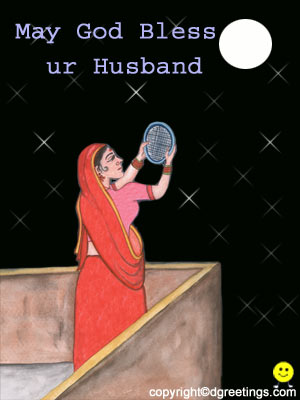

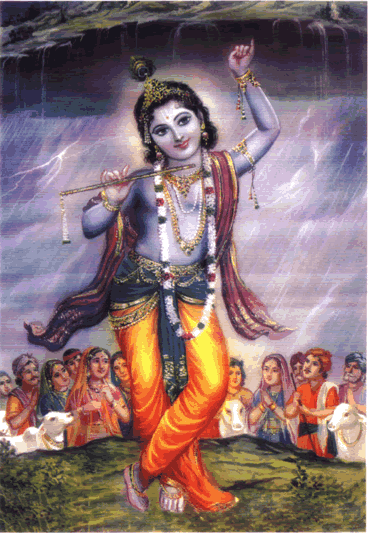
Preparations for worship of Indra
**********************************
One day, seven year old Krishna, became intrigued
by the hectic activity going on in the His village of Vrindavana. His father,
Nanda Maharaja, was busily directing all the preparations with help of
the village elders. Curious, Krishna began to inquire the reason behind
all this from His father. But Nanda Maharaja being extremely busy, and
thinking Krishna to be too young to understand, ignored His queries.
However, he could not contend with the persistence of
Krishna and finally gave in. He explained that they were arranging for
a big yajna (sacrifice) in the honor of Lord Indra, the king of the demigods.
Since they belonged to the farming community (Vaisya), they were very dependant
on timely rainfall for their crops and food grains. Lord Indra being
the controlling deity of rainfall was therefore being propitiated by the
yajna to ensure timely and sufficient rainfall.
Krishna dissuades His father
****************************
Krishna however began to dissuade His father from this
sacrifice. Overtly, He took the position of a karma-mimamsa, a class of
atheist philosophers that propose that since God is bound to reward or
punish one in accordance with one's karma, a person should simply focus
on performing his activity and enjoy the results. This argument was countered
by Nanda Maharaja that while activity is essential, the mercy is
also needed. Krishna however nullified these arguments saying that Indra
sends rains even to the oceans, since he himself is duty bound to do so.
Since demigods will be satisfied by the proper execution of duties, there
is no need to worship them separately.
Krishna instead proposed that they should worship the
local Brahmans and Govardhana hill. Since the Brahmans were the spiritual
leaders of the community and Govardhana hill was providing them with so
many amenities like grass, water and shelter for the cows, which are the
primary assets of the village community. Even though Krishna was debating
from an atheistic view point, He had a higher purpose in mind. His descent
to the world was to discourage the worship of demigods for material gains,
and to establish the true position of the Supreme Personality of Godhead.
He was aware that Lord Indra was very much proud of his position as the
king of the demigods. Since Lord Indra is actually a great devotee, Krishna
was also showing him His mercy by removing the illusion of false pride
from him.
Nanda Maharaja agrees with Krishna
********************************
Even though Nanda Maharaja was very affectionate to Krishna,
he was reluctant to give up the traditional ceremony they had been performing
for years. So he offered a compromise, that the Govardhana puja would be
done after the Indra yajna was completed. However this did not satisfy
Krishna. He does not like wishy-washy compromises but clear and uninterrupted
commitment. Finally out of affection for Krishna, the villagers lead by
Nanda Maharaja relented and began to worship the Govardhana in accordance
to the instructions of Krishna.
Thus was established the tradition of the worship of Govardhana,
which is followed to this day in a festival called Annakuta. They began
the worship by first circumambulating Govardhana hill, a tradition that
is followed even now. After Nanda Maharaja and the Brahmins concluded the
ceremony, they were awed to see Govardhana personified, personally accepting
the foodstuffs offered in the ceremony. They were joyfully surprised to
see that Govardhana personified look exactly like Krishna, and from this
we can understand that Govardhana is actually non-different from the Supreme
Personality of Godhead. To this day, qualified devotees take small rocks
(shilas) from the Govardhana hill to worship as the deity form of the Lord.
Lord Indra angered
******************
Lord Indra was however most displeased with this. Even
though he was aware of the position of Krishna, anger and pride caused
him to become illusioned, a symptom that is common in present day materialists.
Furious, he summoned the Samvartaka clouds, specially powerful clouds used
at the time of cosmic destruction, and ordered them to pour rain over Vrindavana.
So powerful were these rain clouds that soon entire Vrinadavana was
deluged under rain fall as thick as columns and as sharp as arrows,
causing much pain to the people in Vrindavana. The inhabitants of Vrindavan
were all pure devotees of Sri Krishna, and in distress turned to
Him for shelter.
Govardhana hill lifted by
Krishna
*********************************
The omniscient Lord, very much aware of the machinations
of Lord Indra, simply picked up the Govardhana hill and asked all the inhabitants
of Vrindavana to take shelter under the hill with their families and animals.
In this way, Krishna held the mountain up for seven days on the little
finger of His left hand. By His mystic potency, no one felt any hunger,
thirst or discomfort for the entire time they spent under the hill. Finally
when Indra realized that he was actually up against the Supreme Personality
of Godhead, he immediately ordered the clouds to stop. The inhabitants
of Vrindavana happily went back, singing the glories of Krishna, and Krishna
replaced the Govardhana hill to its original position.
Lord Indra forgiven
*******************
Now Lord Indra was terrified at his offenses. Knowing
that Krishna is specially merciful to the cows, he enlisted the help of
Surabhi, the personification of the cows in the spiritual world. He stealthily
approached Krishna in a secluded place and fell prostrate at His feet.
In beautiful prayers, Lord Indra begged for forgiveness and the mercy
of Krishna. Since Krishna is always favorably disposed to His sincere devotees,
He forgave Indra and cautioned him against false pride. He also pleasingly
received the worship from Surabhi and many other denizens of the heavenly
planets.
The descent of Govardhana
*************************
In the Padma Purana it is mentioned that when the Lord
descends to performs His pastimes, He does so accompanied by His associates
and intimate paraphernalia. Part of the paraphernalia is the actual land
where the pastimes are performed. Thus the entire tract of land known as
Braja Mandala is said to have descended from the spiritual world into the
material. When Krishna wound up His pastimes, He left behind this holy
dhama for His devotees to enjoy and draw inspiration from.
Along with the Braja Mandala also descended Govardhana
hill on which Krishna performed so many of His childhood pastimes. Since
the Lord personally picked it with His hands, it is considered non-different
from Him. So enjoyable is this pastime of Krishna to His devotees, that
He is also called Giridhari, meaning one who holds the mountain. When Krishna
descended later as Caitanya Mahaprabhu, in the mood of His own devotee,
He refused to set foot on Govardhana, recognizing it to be non-different
from the Lord.
Vanishing Govardhana
********************
In the Garga Samhita, it is said that Govardhana Hill
was once cursed by Pulastya Muni, a powerful mystic and one of the sons
of Lord Brahma. The curse was that every day Govardhana would reduce by
the size of one seed of mustard. In accordance with the curse, Govardhana,
which was initially two yojnas (sixteen miles) tall, has since been reducing
in size. The scriptures say that as long as Govardhana hill and river Yamuna
are present, there will be religiosity and God consciousness. On the day
they disappear, which is predicted to happen some ten thousand years from
now, Kali yuga will start in earnest and any semblance of religion will
completely disappear.
So while we can, let us relish the pastime of Govardhana,
and if and when we get the opportunity, take darshana and perform the most
auspicious parikrama (circumambulate) Govardhana.
***********************************************
All glories to Giri Govardhana and Giridhari !!
***********************************************
Read
all about Govardhan puja and related topics HERE

The following Sections are from Sri Gaudiya Kantahara
Without the Mercy of Gauräìga
it is Impossible
to Control the Senses or Practice
Bhakti
13.138
kälaù kalir balina indriya-vairivargäù
çré bhakti-märga
iha kaoöaka-koöi-ruddhaù
hä hä kva yämi vikalaù
kimahaà karomi
caitanyacandra yadi nädya kåpäà
karoñi
Now it is the age of Kali.
My enemies, the senses, are very strong. The beautiful path of bhakti is
spiked with countless thorns. My spirit is weak. My senses are powerful
and agétäted. O what shall I do? Where shall I go? O Lord Caitanya-candra,
if you do not grant me Your mercy, what shall I do to save myself? (Caitanya-candämåta
125)
The Six Kinds of Çaraëägati
13.139
änukülyasya saokalpaù
prätikülyasya varjanam
rakñiñyatéti
viçväso goptåtve varaëaà tathä
ätma-nikñepa-kärpaëye
ñaò-vidhä çaraëägatiù
The six divisions of surrender
are to accept those things favorable for devotional service, to reject
unfavorable things, the conviction that Kåñëa will give
all protection, to accept the Lord as one's guardian or master, full self-surrender,
and humility. (Cc. Madhya 22.100, from Vaiñëava Tantra)
Without Çaraëägati
There Can be no Auspiciousness
13.140
tävad bhayaà draviëa-deha-suhån-nimittaà
çokaù spåhä
paribhavo vipulaç ca lobhaù
tävan mamety asad-avagraha
ärti-mülaà
yävan na te 'oghrim abhayaà
pravåëéta lokaù
O my Lord, the people of the
world are embarrassed by material anxieties they are always afraid. They
always try to protect wealth, body, and friends. They are filled with lamentation
and unlawful desires and paraphernalia; and they avariciously base their
undertakings on the perishable conceptions of "my" and "mine". As long
as they do not take shelter of Your safe lotus feet, they are full of such
anxieties. (Bhäg. 3.9.6)
13.141
kärpaëya-doñopahata-svabhävaù
påcchämi tväà
dharma-sammüòha-cetäù
yac chreyaù syän niçcitaà
brühi tan me
çiñyas te 'haà
çädhi mäà tväà prapannam
Now I am confused about my
duty and have lost all composure due to weakness. In that condition I am
asking You to tell me clearly what is best for me. Now I am Your disciple
and soul surrendered unto You. Please instruct me. (Bhagavad-gétä
2.7)
13.142
daivé hy eñä guëa-mayé
mama mäyä duratyayä
mäm eva ye prapadyante
mäyäm etäà
taranti te
This divine energy of Mine,
consisting of the three modes of nature, is difficult to overcome, but
those who have surrendered unto Me can easily cross beyond it. (Bhagavad-gétä
7.14)
13.143
yeñäà sa eña
bhagavän dayayed anantaù
sarvätmanäçrita-pado
yadi nirvyalékam
te dustaräà atitaranti
ca deva-mäyäà
naiñäà mamäham
iti dhéù çva-çågäla-bhakñye
Anyone who is specifically
favored by the Supreme Lord, due to unalloyed surrender to the service
of the Lord, can overcome the insurmountable ocean of illusion and can
understand the Lord. But those who are attached to the body, which is meant
to be eaten by dogs and jackals cannot do so. (Bhäg. 2.7.42)
13.144
ananyäç cintayanto mäà
ye janäù paryupäsate
teñäà nityäbhiyuktänäà
yoga-kñemaà vahämy aham
But those who are always attached
to Me, who worship Me with devotion, meditating on My transcendental form
to them I carry what they have and preserve what they lack. (Bhagavad-gétä
9.22)
13.145
kåñëa-bhakti-sudhäpänäd
deha-daihika-vismåteù
teçäà bhautikadehe'pi
sac-cid-änanda-rüpatä
Drinking the nectar of Kåñëa-bhakti-rasa,
the living being forgets the gross and subtle material bodies and becomes
absorbed in transcendence. The body of such a devotee, although material,
attains the qualities sat, cit, and änanda, or eternity, knowledge,
and bliss. (Båhad-bhägavatämåta 2.3.45)
13.146
çaraëa laïä
kare kåñëe ätma-samarpaëa
kåñëa täre
kare tat-käle ätma-sama
When a devotee fully surrenders
to Kåñëa, offering his very self, at that time Kåñëa
accepts the devotee to be as good as His very self. (That is, the Lord
accepts Him as one of his own personal associates.) (Cc. Madhya 22.102)
13.147
prabhu kahe,--"vaiñëava-deha
'präkåta' kabhu naya
'apräkåta' deha bhaktera
'cid-änanda-maya'
dékñä-käle
bhakta kare ätma-samarpaëa
sei-käle kåñëa
täre kare ätma-sama
sei deha kare tära cid-änanda-maya
apräkåta-dehe täora
caraëa bhajaya
Caitanya Mahäprabhu said,
"The body of a devotee is never material. It is considered transcendental,
full of spiritual bliss. At the time of initiation, when a devotee fully
surrenders unto the service of the Lord, Kåñëa accepts
him to be as good as Himself. When the devotee's body is thus transformed
into spiritual existence, the devotee, in that transcendental body, renders
service to the lotus feet of the Lord. (Cc. Antya 4.191-193)
13.148
dante nidhäya tåëakaà
padayor-nipatya
kåtvä ca käkuçatam
etad ahaà bravémi
he sädhavaù sakalam
eva vihäya düräd-
gauraìga-candra-caraëe
kurutänurägam
Taking a straw in my teeth
I fall at your feet hundreds of times and implore you with sweet words,
saying, "O noble soul! Please throw out everything you have learned and
cultivate attachment to the lotus feet of the moonlike Çré
Gauräìga. (Caitanya-candämåta 120)
Humility
13.149
na prema-gandho 'sti daräpi
me harau
krandämi saubhägya-bharaà
prakäñitum
vaàçé-viläsy-änana-lokanaà
vinä
vibharmi yat präëa-pataìgakän
våthä
My dear friends, I have not
the slightest tinge of love of Godhead within my heart. When you see me
crying in separation, I am only making a false show of devotion. The proof
that I have no love for Kåñëa is the fact that while
not seeing His beautiful face as He plays His flute I continue to maintain
My fly like existence. (Cc. Madhya 2.45)
The Value of Association With a Pure
Devotee
13.150
ata ätyantikaà kñemaà
påcchämo bhavato 'naghäù
saàsäre 'smin kñaëärdho
'pi sat-saìgaù çevadhir nåëäm
O sinless ones! We therefore
inquire from you about that which is supremely auspicious for all living
beings, for in this world association with saints even for a half a moment
is the most valuable treasure in human society. (Bhäg. 11.2.30)
13.151
tulayäma lavenäpi na svargaà
näpunar-bhavam
bhagavat-saìgi-saìgasya
martyänäà kim utäçiñaù
Elevation to the heavenly planets
and liberation from material existence cannot be compared to even a moment's
association with a pure devotee of Kåñëa. What then can
be said of material benedictions, which are for those who are destined
to die? (Bhäg. 1.18.13)
13.152
bhayaà dvitéyäbhiniveçataù
syäd éçäd apetasya viparyayo 'småtiù
tan-mäyayäto budha äbhajet
taà bhaktyaikayeçaà guru-devatätmä
Fear arises when a living entity
misidentifies himself as the material body because of absorption in the
external, illusory energy of the Lord. When the living entity thus turns
away from the Supreme Lord, he also forgets his own constitutional position
as a servant of the Lord. This bewildering, fearful condition is effected
by the potency for illusion, called mäyä. Therefore, an itelligent
person should engage unflinchingly in the unalloyed devotional service
of the Lord, under the guidance of a bona fide spiritual master, whom he
should accept as his worshipable deity and as his very life and soul. (Bhäg.
11.2.37)
The Çrutis Identify the Worship
of Devotees and Association
with Saints as the Only Thing Worth
Doing
13.153
tasmäd-ätmajïaà
hyarcayed-bhütikämaù
A person wishing to attain
divine opulence should worship one who is ätmajïa, self-realized.
That is, he should worship a devotee of Çré Hari, the Supreme
Personality of Godhead. (Muëòaka Upaniñad 3.1.10)
Sädhu-saëga is the Only
Way
13.154
rahügaëaitat tapasä
na yäti na cejyayä nirvapaëäd gåhäd vä
na cchandasä naiva jalägni-süryair
vinä mahat-päda-rajo-'bhiñekam
My dear King Rahügaëa,
unless one has the opportunity to smear his body with the dust of the lotus
feet of great devotees, one cannot realize the Absolute Truth. One cannot
realize the Absolute Truth simply by observing celibacy, by worshiping
the Deity, by taking sannyäsa, by perfectly following the rules of
the gåhastha äçrama, nor can one attain the truth by
accepting severe penances and austerities, by studying the Vedas, nor by
worshiping the gods of water and sun. Only by bathing in the dust of the
lotus feet of a pure devotee is the Absolute Truth revealed. (Bhäg.
5.12.12)
Those Who Have Few Pious Credits
Cannot Get the Association of Great
Souls
13.155
duräpä hy alpa-tapasaù
sevä vaikuëöha-vartmasu
yatropagéyate nityaà
deva-devo janärdanaù
Those whose austerity is meager
can hardly obtain the service of the pure devotees, who are progressing
on the path back to the kingdom of God, Vaikuëöha. Pure devotees
engage one hundred percent in glorifying the Supreme Lord, who is the Lord
of the demigods and the controller of all living entities. (Bhäg.
3.7.20)
13.156
naiñäà matis tävad
urukramäìghrià
spåçaty anarthäpagamo
yad-arthaù
mahéyasäà päda-rajo-'bhiñekaà
niñkiïcanänäà
na våëéta yävat
Unless they smear upon their
bodies the dust of the lotus feet of a Vaiñëava completely
free from material contamination, persons very much inclined toward materialistic
life cannot be attached to the lotus feet of the Lord. Only in this way
can one be free from material contamination. (Bhäg. 7.5.32)
A Devotee Has all Good Qualities;
a Non-devotee Has None
13.157
yasyästi bhaktir bhagavaty akiïcanä
sarvair guëais tatra samäsate
suräù
haräv abhaktasya kuto mahad-guëä
manorathenäsati dhävato
bahiù
All demigods and their exalted
qualities, such as religious knowledge and renunciation, become manifest
in the body of one who has developed unalloyed devotion for the Supreme
Personality of Godhead, Väsudeva. On the other hand, a person devoid
of devotional service and engaged in material activities has no good qualities.
Even if he is adept at the practice of mystic yoga, or the honest endeavor
of maintaining his family and relatives, he must be driven by his own mental
speculations and must engage in serving the Lord's external energy. How
can there be any good qualities in such a person? (Bhäg. 5.18.12)
From Sädhu-saëga Comes
Faith, Devotional Attachment, and Prema-bhakti
13.158
satäà prasaìgän
mama vérya-saàvido
bhavanti håt-karëa-rasäyanäù
kathäù
taj-joñaëäd äçv
apavarga-vartmani
çraddhä ratir bhaktir
anukramiñyati
In the association of pure
devotees, discussion of the pastimes and activities of the Supreme Personality
of Godhead is very pleasing and satisfying to the ear and the heart. By
cultivating such knowledge one gradually becomes advanced on the path of
liberation. Thereafter he is freed, and his attraction is fixed. Then real
devotion and devotional service begin. (Bhäg. 3.25.25)
With Humility and Hankering for Kåñëa,
a Devotee Prays as Follows
13.159
na dhanaà na janaà
na sundaréà kavitäà vä jagadéça
kämaye
mama janmani janmanéçvare
bhavatad-bhaktir-ahaituké tvayi
O almighty Lord, I have no
desire to accumulate wealth, nor do I desire beautiful women, nor do I
want any number of followers, nor do I care for the fame of a poet, or
the poetically glorified position of impersonal liberation I only want
Your causeless devotional service birth after birth. (Çikñäñtakam
4)
Thus ends the Thirteenth Jewel of
the Gauòéya Kaëöhahära, entitled Sädhana-bhakti-tattva.
taken from Gaudiya Kantahara Thirteenth Jewel Sadhana-bhakti-tattwa

All pictures from Srimad Bhagavatam and Iskcon works - Copyright ©2005
The Bhaktivedanta Book Trust
International, on the web at .http://www.krishna.com/.
Used with permission.









![]()
![]()
![]()

![]()
![]()
![]()
![]()

![]()
![]()
![]()
![]()
















 .....
..... .....
.....

 Restricting
our eating for last month of
Restricting
our eating for last month of  Offering lamps
for the Lord's pleasure (as mentioned in the Diwali section above)
Offering lamps
for the Lord's pleasure (as mentioned in the Diwali section above)


